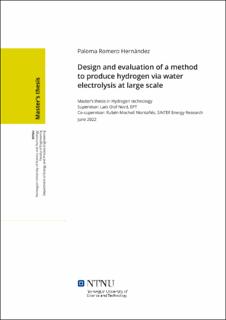| dc.description.abstract | Hydrogen has unique properties that can transform our fossil-fuel dependent economy into an hydrogen one. This element is the lightest and most abundant in the universe and its many industrial applications make it be a promising alternative to build clean path-ways. Nowadays, it can be produced from several sources such as steam reforming of natural gas, which is a widely used hydrogen production technology, but environmentally friendly production is a pressing issue. Therefore, it is important to switch to cleaner, more sustainable primary energy sources such as water electrolysis. Furthermore, clean hydrogen is currently in unprecedented political and commercial momentum, with policies and projects growing rapidly worldwide. However, due to the low density of hydrogen, its storage and transport are subjects of intense research.
The sustainability of hydrogen production technology lies in the way it is produced, so this work is focused on comparing two different approaches of producing hydrogen through seawater electrolysis at large scale. The aim is to provide 50 MW of energy to a refinery, using 5 electrolysers of 10 MW each one. Nowadays, each electrolyser's stack has its own balance of plant, so the first approach consists on simulating 5 electrolysers with 5 different equipment of each type. However, it is believed that a shared balance of plant can lead to lower costs with a better or similar efficiency, so the second approach is focused on simulating a model with 5 electrolysers as well, but sharing the rest of the equipment needed. Both models have been simulated using Aspen HYSYS. To compare the results, different scenarios are being considered using costs' correlations and the Aspen Capital Cost Estimated tool of AspenTech. For this tool, three scenarios are analysed: compression at different pressures without considering the storage, compression at different pressures considering one-day of storage, and compression at different pressures considering the necessary storage to provide three different periods of autonomy to the refinery (5, 10 and 15 days). The pressure of compression range considered varies between 350 and 800 bar.
At large, results show that the common balance of plant reduces the total final costs, specially when the pressure of compression is low. Considering different pressures of compression shows that the price is lower when the pressure is low because less energy input is needed to compress the stream. However, due to the low density of hydrogen, compressing up to the lowest value of the pressure's range means that a smaller amount of hydrogen can be stored. The second scenario of considering the storage corroborates that the higher the pressure of compression is, the higher the amount of hydrogen is. Nevertheless, when increasing this pressure the thickness of the walls of the tanks also increases since more material is needed, which causes higher costs. Finally, the last scenario shows a very hypothetical case in which the final cost increases considerably when larger periods are considered. There is a clear uptrend when increasing the days of autonomy depending on the number of tanks needed, which is different in each case, and on the capacities and prices of these tanks depending on the pressure considered. The results will vary depending on the project and on the boundary conditions that are considered, so it is up to each one the decision of compressing up to a certain pressure and for how long storing the product according to the necessities. However, for this case study in particular, a shared balance of plant will provide better profits. | |
